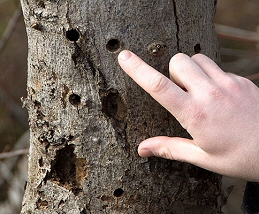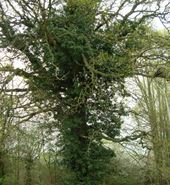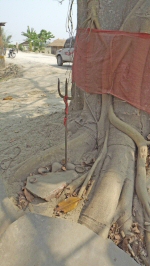Newsletter
Current
Previous
|
June 2012
|
|
|
|
|
CONFLICTS IN NATURE
A SUCCESS STORY, WE THOUGHT! The newsletter contains several articles which chronicle conflicts in nature. The successful reintroduction of the red kite and the increase in numbers have upset one or two people, causing a bad press for the bird, accusing it of making off with much-loved pets. Ray Reedman puts the case straight below.
 UNWANTED GUESTS: Sometimes trading with other countries means we import more than intended for our money, Dutch elm disease being a case in point. The latest unwanted alien to come uninvited to our shores is the Asian Longhorn Beetle, but no need to panic as at the moment it is contained in a wood in the unfortunate town of Maidstone (see article below). As there is no known way of treating an infected tree, felling has to be carried out. UNWANTED GUESTS: Sometimes trading with other countries means we import more than intended for our money, Dutch elm disease being a case in point. The latest unwanted alien to come uninvited to our shores is the Asian Longhorn Beetle, but no need to panic as at the moment it is contained in a wood in the unfortunate town of Maidstone (see article below). As there is no known way of treating an infected tree, felling has to be carried out.
A LOST BATTLE FOR EARLEY'S ANCIENT LANDSCAPE: Our insatiable desire for mobile phones means more and more masts are required, and one of the few remaining pieces of ancient woodland in Earley, Redhatch Copse, will now have a 30 metre mast in its midst, courtesy of the owners, Reading University, with all the accompanying disruption in building and incursions into the Copse. The mast will also carry emergency services communication. The Copse must once have been full of birdsong, wild flowers and a variety of mammals. Sad to think that as recently as 1981 this copse held a nest of young dormice. See here for the current situation, and here for a more reverent attitude to trees.
|
|
|
|
| TREES UNDER THREAT
|
|
The Asian Longhorn Beetle (Anoplophora glabripennis) has arrived in the UK and it's not good news for trees.
Where is it? At the moment (as of 5th April) FERA (The Food and Environment Research Agency - part of DEFRA) believe they have contained an outbreak in a wood in Maidstone.
Where did it come from? China/Far East.
How did it get here? Probably in untreated packing case wood.
What does it do? The beetle and lava eat the sapwood and heart wood of many deciduous tree species eg maples, willows, poplars and even mulberries. As they are so big this physically weakens the wood, sometimes they can girdle the tree which cuts off sap flow, and finally the large exit holes allow secondary threats into the tree.
What can be done? Nothing for infected trees. If the beetle is discovered, quarantine and felling of the tree and all trees in a 100m radius will be considered by FERA. This is why prevention of the spread of the beetle is the only defence.
What can I do? As you are out walking, looking at trees - look especially for the 1-cm-wide exit holes. From May to August the adults emerge, and there could be some wood dust in the vicinity of the holes.
What should I do if I find one? FERA says - Anybody finding one of these distinctive beetles should secure the specimen (preferably in a sealed glass jar). They should contact the Fera Plant Health Helpline 0844 2480071 or email the information to planthealth.info@fera.gsi.gov.uk, along with a good-quality digital photo if possible. An inspector can then collect it.
For more information and pictures see:-
Centre for Invasive Species (America)
The Forestry Commission
|
|


|
|
The above important information first appeared in TREE WATCH published by the Wokingham District Veteran Tree Association. See their excellent website
|
|
The ever-diminishing ancient landscape
|
|
Birds singing in Redhatch Copse, April 30th two days before work commenced on erecting 30 metre mast in Redhatch Copse:
|
|
Blackcap (m) singing & seen foraging.
Wren singing & seen
Chiffchaff singing & seen
Blue Tit singing & seen
Robin singing & seen
|
 Chaffinch singing & seen
Chaffinch singing & seen
Great Tit singing & seen
Blackbird singing & seen
Jay seen
|

The above was recorded by Anne and John Booth, members of EEG, and passed to Ben Kite, ecologist responsible for the University's consultancy. All birds were seen around the edge of the compound area or flying through it. Most were singing, indicating they were nesting or looking to nest in the area. The mast installation is now proceeding.
Redhatch Copse is defined as ancient semi-natural woodland, which is composed of native tree species that have not obviously been planted. Ancient woodland is likely to have existed continuously since 1600. Looking at maps dating from the mid-1700s to present day, Redhatch Copse has maintained exactly the same shape.p
Natural England states that 'Woods planted or growing up today will not become ancient woods in 400 years' time because the soils on which they have developed have been modified by modern agriculture or industry, and the fragmentation of natural habitats in today's landscape hampers species' natural movements and interactions.
Our remaining semi-natural ancient woodland is therefore irreplaceable. If we lose what little we have left then it is gone forever.'
|
|
THREATS TO OUR PETS?
Ray Reedman writes: 'Someone recently drew my attention to a local newsletter which contained some serious allegations against a local favourite. A few days later, local media carried a story on similar lines. The new villain on the block is apparently the gorgeous Red Kite, which is accused of threatening behaviour towards small pets, in particular a small Pomeranian.
'Most sources will tell you that Red Kites are primarily carrion eaters. They search out dead animals and will feast happily alongside crows, ravens and the like to cleanse the landscape of decaying flesh and thus remove the potential sources of disease. That is the function which they served in Britain historically, when they scavenged in towns on the detritus thrown into the streets before the days of refuse collection and modern sewage. Some of their kin still serve the same function in other parts of the world.
'When compared with some other birds of prey, the Red Kite has one huge disadvantage: its feet are puny and its claws much less developed than, say, a Buzzard. It has just not evolved to catch large prey.'
Ray goes on to point out that kites may take small birds, often the weak and unwary ones. Prey would not generally be larger than a brown rat, a small hare or young rabbit and it may be wise to keep poultry or small pets supervised outside or given the benefit of a wire run. 'A full-grown cat or proper dog should have no cause for alarm.'
Want to know more about the Red Kite? MAKE 10th SEPTEMBER A DATE IN YOUR DIARY FOR THE EEG TALK ON RED KITES BY BRIAN CLEWES, 19.00 to 21.00 , at the Oracle Corporation, Thames Valley Park. Details on page 8.
|
|
| |
"Thinking about composting?" Anne Booth thinks you should
|
|
|
 The ending of free green waste collections in our area may leave people wondering what to do with everything they used to put in their green bag. One solution is to compost it. The resulting product can be used to feed the soil and make potting mixes. Around 40 per cent of average dustbin contents are suitable for home composting so it helps cut down on landfill and saves money too! The ending of free green waste collections in our area may leave people wondering what to do with everything they used to put in their green bag. One solution is to compost it. The resulting product can be used to feed the soil and make potting mixes. Around 40 per cent of average dustbin contents are suitable for home composting so it helps cut down on landfill and saves money too!
Compost bins
These can be bought from DIY stores or garden centres: there are several different types and sizes to choose from, or you can make your own. Or indeed you can just pile compost material in a heap in a suitable place in the garden.
The quickest way to build your own that I've seen is to acquire 4 pallets, wire 3 together to form a square, then wire the last pallet onto one side to make a gate. The structure can be stabilised by driving in stakes inside at the corners.
For a simple design that involves a bit of DIY, Garden Organic give instructions. It is recommended that any bin be a minimum size of 2'6" (75cms) square, and that it is sited in a sunny or semi-shaded position directly on the soil. It should be covered with a lid or old carpet to keep the rain off. I've found that it's good to let some rain in as otherwise it gets too dry.
What to put in
Anything of plant origin, eg grass mowings, weeds (but not persistent ones like couch grass & ground elder), vegetable peelings, tea bags, coffee grounds.
Woody items such as prunings. These decay very slowly so are best chopped or shredded first.
Manure and bedding from herbivores, eg horses, cows and chickens.
Sawdust, wood shavings, egg boxes, shredded confidential documents.
Leaves, though these are best composted separately, as they rot down slowly.
What to leave out
Meat, fish, cooked food , coal & coke ash, cat litter, dog faeces, disposable nappies.
How to make it
To make the very best compost quickly you need a more or less equal amount of things that rot down quickly and those that don't - the so called 'greens' and 'browns', and you have to do things like turning the compost every so often to mix it all up. However, I've discovered a lazy way which seems to work. I have two wooden-walled heaps side by side with one 'on the go' and one covered over and rotting down. I just hurl things on to the active heap until I empty the 'resting' one in the early spring, which has miraculously turned into good, brown compost. This emptied bin then becomes the new heap, and I cover the full bin and leave to rest for 12 months.
For a fuller account of everything compost, have a look at http://www.gardenorganic.org.uk/composting/index.php or contact Garden Organic, Coventry, Warwickshire, CV8 3LG Tel 024 7630 3517.
|
|
To help out, if you can't get rid of everything, Wokingham Borough Council has provided Community Skips. These call at certain points in Earley every six weeks, and you can take along anything that will fit into your car, except fridges/freezers, televisions, computer monitors, and strip lights. Check the WBC website for locations and times, or phone WBC on 974 6000.
|
|
|
SACRED TREES
 Early man, noting the seasonal changes in trees and plants around him, must have been filled with awe at the invisible power governing these changes. We had sacred groves in ancient times, and oaks were especially venerated. Numerous countries still worship trees. The picture on the left was taken in Assam, India, and trees along the roads were wrapped in cloth, signifying them to be holy, and had offerings given by local people. Many trees, like the banyan, are considered sacred by several Indian religions. Early man, noting the seasonal changes in trees and plants around him, must have been filled with awe at the invisible power governing these changes. We had sacred groves in ancient times, and oaks were especially venerated. Numerous countries still worship trees. The picture on the left was taken in Assam, India, and trees along the roads were wrapped in cloth, signifying them to be holy, and had offerings given by local people. Many trees, like the banyan, are considered sacred by several Indian religions.
Another sacred tree is the pipal tree. One in particular is creating a furore. A village of Buddhists (who are staunch environmentalists) is caught in a quandary of choosing between religion and nature.
Hundreds of storks, which have nested on the sacred pipal tree, have become a threat to the tree's survival, forcing the villagers to move the forest
department to take steps to protect both the tree and the storks in Banglung village in Assam's Karbi Anglong district. The Buddhist villagers prefer to live in perfect harmony with nature. The headman, Sushen Shyam, said the villagers had thought of chasing the birds away to save the tree but decided not to do so because it went against their religion. A real dilemma!
|
We may not say we 'worship' trees, but some would say they cherish them and would go to great lengths to protect them.
A total of 462 veteran trees, mostly oaks, have been surveyed in Earley. (May 2012)
| |
Offerings of lamps and symbols at the foot of the tree
|
|
 |
|
|
| | Can you name these flowers, painted by EEG member Patricia Brown?
Hover the mouse pointer over the picture for the answer
|
|
|
|
|
|
The unpalatable truth to be faced in a world so dependent on oil
Report of EEG talk, 'Peak Oil', by Dr Roger Bentley
Dr. Roger Bentley's talk on 25th April rang alarm bells about the economic impacts of the expected decline in global oil production in the near future, but at least the prospect of continuing high prices should add weight to calls to reduce its use on environmental grounds.
Dr. Bentley's analysis, which was primarily concerned with conventional liquid oil supplies as opposed to gas or shale oils, did cast doubt on the economic and energy costs of using these alternative sources to provide liquid fuels. Globally most oil had been discovered before 1980, since which time we have been using more than has been found. For conventional oils UK production peaked in about 1999, and global production seems to have hit a ceiling in about 2005. Production from conventional and unconventional sources is expected to peak before 2030.
The talk also demonstrated the complexity of this subject. Differences between Proved and Probable reserves, unextractable reserves, false data submitted by suppliers, the costs and effects of injecting water and chemicals into oil wells to increase recovery, changes in demand, and the differences in reserves in different countries - all add to uncertainty of forecasting, but the general picture was pretty clear.
Dr. Bentley has been a member of a Reading University group studying peak oil since 1994, and has published a number of papers on the topic. He was a Co-ordinator of the Oil Depletion Analysis Centre (ODAC), and a past Secretary of the Association for the Study of Peak Oil & Gas (ASPO). Over the years they have tried to persuade governments to take more action, but with little success. His presentation can be seen as Powerpoint slides or as PDF.
Report written by John Booth

|
|
NEWS FROM BEYOND EARLEY
We over-estimate how much food we need, and under-estimate how much we throw away. This is asserted in a recent survey by food giant BirdsEye; UK families are wasting £270 a year (£5.20 a week) on discarded food and drink, according to the survey of our kitchen habits. The increasing sales technique of Buy One Get One Free, or 3 For The Price Of 2, may explain why we have a surfeit which is not consumed and thrown away, vegetables topping the list. People were surprised at how much was being wasted. This is only one survey but others seem to suggest similar food wastage.
|
EARLEY NEWS and WILDLIFE SIGHTINGS
Our garden survey news from Gillian and Margaret for April:
Aside from the usual bird visitors, they both recorded dunnock and jay; Gillian noted green woodpecker and chaffinch (seed feeder); Margaret recorded crow and coal tit. On 13 April Gillian saw a holly blue butterfly and on the same day Margaret spotted orange tip and small white, which indicates it was probably a sunny day. Margaret wrote that the cuckoo was heard over Highwood. What a pity it couldn't tell us its travel adventures.
An interesting little plant in Whitenights Park
1MAY 6: In Whiteknights Park, a clump of Spring Beauty (Claytonia perfoliata) growing at the base of a tree stump. Other names - Miner's lettuce, Winter Purslane, and Indian lettuce. An introduced plant with conflicting versions of when it was first introduced. Geoffrey Grigson labels it an American weed and not observed in GB until 1852.
 One website entry by an enthusiast for the plant in the Netherlands gives an interesting account of it by quoting from Curtis's Botanical Magazine of 1811 in which there's a piece on Miner's Lettuce and how it was first introduced to Europe. Archibald Menzies (1754-1842), Scottish botanist and physician and an intrepid world-traveller, was the naturalist aboard H.M.S. Discovery, famously captained by George Vancouver (1757-98) during the marvellous expedition of 1791-1795. Menzies found Claytonia perfoliata on the western seaboard of North America and named it after the famous colonial plant collector John Clayton (1694-1773). One website entry by an enthusiast for the plant in the Netherlands gives an interesting account of it by quoting from Curtis's Botanical Magazine of 1811 in which there's a piece on Miner's Lettuce and how it was first introduced to Europe. Archibald Menzies (1754-1842), Scottish botanist and physician and an intrepid world-traveller, was the naturalist aboard H.M.S. Discovery, famously captained by George Vancouver (1757-98) during the marvellous expedition of 1791-1795. Menzies found Claytonia perfoliata on the western seaboard of North America and named it after the famous colonial plant collector John Clayton (1694-1773).
The stems have one pair of leaves united in a whorl below the flowers.
|
|
LOCAL FORTHCOMING EVENTS 2012
Thursday, 7th June at 7 p.m. St. Nicholas Church, Hurst, A LICHEN WALK WITH MARTIN HASLAM
Following on from his talk last autumn and the walk around Maiden Erlegh Nature Reserve to look for lichens there, Martin is taking us to St. Nicholas Church to look at the lichens found on stone. There will be an optional pub visit afterwards. Bring a hand lens or magnifier.
Sunday, 8th July 2-4 pm A WALK TO LOOK AT WILDLIFE IN THE MAIDEN ERLEGH NATURE RESERVE.
Led by Grahame Hawker, meet at Interpretation Centre, Instow Road. All Welcome.
Saturday, 4th August, 10.00 to 15.00.
Join us for our annual Green Fair at the Maiden Erlegh Nature Reserve.
Wednesday, 8th August, Children's Annual Bug Hunt 10.00 to 12.00
Meet at the Interpretation Centre, Instow Road. Places must be booked as numbers are limited. Come prepared for any weather. Minimum age 4 years. Responsible adults to accompany children aged up to 8yrs. Contact Sheila Crowson on 962 0004 for details. Please give a contact number. Also enrol at the Green Fair..
Monday September 10th, 7.30 to 9.30 pm, Red Kites, A talk by Brian Clewes
You've seen them flying majestically over your gardens, now find out all about them. Building 550 Restaurant, Oracle Corporation UK Limited, Oracle Parkway, Thames Valley Park, Reading RG6 1RA. Contribution to expenses welcome.
To find the venue in Oracle Building 550 please enter Thames Valley Park off the last roundabout at the very end of the 329M. Proceed to the next roundabout (TVP Security Lodge) and take the second exit. At the next roundabout take the third exit and enter the Oracle campus. Building 550 is the first building on the right. Enter the car park and park adjacent to the building. Follow the signs and enter the building via the main entrance and the front. The restaurant is located on the ground floor. We are most grateful to the Oracle Corporation for its support.
|
|
Bits and pieces
EASI (Earley Adopt-a-Street Initiative) is going from strength to strength. They would like more volunteers. Help keep your street clear of litter. Everything provided. Phone Brian Hackett on 0118 986 1115 or email
We need some new blood! Can you offer active help to the Group? If so, phone 0118 962 0004 or go to the website. We would welcome more member involvement. If you have no expertise and would like to get involved, you may be able to give practical help. Perhaps help with distributing the newsletter hard copies, or maybe you have graphic design skills (for occasional posters, leaflets), computer skills, any other skills to offer. Do your bit for the environment.
Join the EEG Yahoo Group and post your sightings and messages. You’ll find a link to Yahoo on our website.
EEG Committee Members can be found on www.earleyenvironmentalgroup.co.uk under Contacts, or phone 0118 962 0004
For Wildlife Survey Forms, go to the website or phone Earley Town Council 0118 986 8995
Comments or contributions to the newsletter to: the Editor or 2 Reeds Avenue, Earley, RG6 5SR. We would welcome short contributions from members to the newsletter.
If you know anyone who would like to join EEG, membership forms are available from Earley Town Council, 0118 986 8995, on the website under Downloads , or send an e-mail to the Membership Secretary. Please inform Liz if you intend to change e-mail or address at 50 Kenton Rd, Earley RG6 7LG, or send her an e-mail.
|
SUPPORT YOUR LOCAL SHOPS
The True Food Co-op, Silverdale Centre :There is now a True Food Co-op operating in Earley, their most successful market. Their mission is to take low cost organic food out to the people, bypassing the supermarkets which charge a lot for organics They hold markets at the Silverdale Centre on Fridays, 5 to 8. 15 pm. They have a website giving dates www.truefood.coop
Pet Fayre 9 Maiden Lane Centre Lower Earley : A small independent shop, with bird feeders of all kinds, a variety of bird feed, large bags of which the shop is willing to deliver locally, or pick it up in your car from the back of the shop, tel 0118 9266512, e-mail sales@petfayre-reading.co.uk or go on the comprehensive website www.petfayre-reading.co.uk
|
|
Thanks to ORACLE Corporation for reproducing our newsletter on recycled paper. Oracle is the world's second largest software company, situated at Thames Valley Business Park in Earley. Oracle UK adheres to the ISO14001 Environment Standard which confirms Oracle has considered and acted upon its environmental impact. As part of Oracle’s corporate social responsibility they support a number of local groups, including us. They have given us valuable support in reproducing the hard copies of our newsletter in colour, as well as printing posters and membership leaflets for us to distribute to libraries, schools etc.
|
|
|